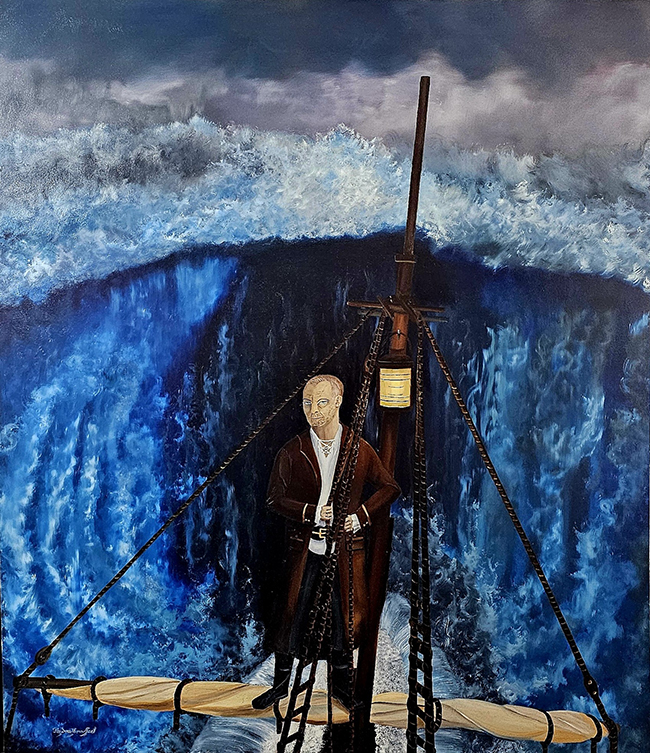Stephen Crawford never expected to find himself with a paintbrush in hand. Fifteen years ago, if someone had suggested he’d become an artist, he probably would’ve laughed. Art was for other people—people with degrees, portfolios, and talent. Crawford didn’t believe he belonged in that world. But sometimes life nudges us. A friend convinced him to join an art class. That single experience cracked something open. Since then, painting has become not just a hobby but a path—one he never saw coming, but now follows with intent. Self-taught, persistent, and emotionally tuned in, Crawford has developed a visual language rooted in determination, symbolism, and raw perseverance.

His painting titled In Defiance captures that spirit in full force. The work features a lone figure standing on the edge of a sinking ship. Behind him, a massive wave rises with biblical intensity, towering over the last bit of deck still visible. The clouds are heavy. The water is dark, churning. And yet—he stands.
The man clings to the mast, flanked by rigging and framed by a single ship’s lantern casting an amber glow. He isn’t panicked. He isn’t pleading. He’s resolved. This is not the look of someone unaware of the inevitable, but someone who’s decided to meet it head-on. The title says it plainly: In Defiance.
Crawford painted this with a message in mind—when everything collapses, when it seems like there’s nothing left to save, the act of standing tall still matters. In his own words, it’s about pushing forward “when everything is against me,” carrying on “to the bitter end.”
The piece is symbolic in many ways. The ocean isn’t just water—it’s pressure, adversity, chaos. The storm can be life’s worst days, or the slow build of unseen stress. The ship represents stability, the structure we rely on to carry us. And the figure is us. Alone. Tested. Reduced to a single decision: do we retreat, or do we remain?
There’s a heavy contrast in the painting between light and dark—soft amber light from the lantern contrasts with deep blues and blacks of the wave and sky. It gives the viewer a focal point, a calm center amid the turbulence. The vertical composition reinforces this idea, with the figure and mast stretching upward, refusing to go under.
You can sense Crawford’s personal connection to the theme. There’s an honesty in the brushwork, especially in the water. It’s not pristine or decorative. It’s messy, thick, agitated. The wave has weight. The ropes holding the figure in place are taut and heavy. Everything about the scene feels loaded with resistance. And still, he holds.
Technically, Crawford brings a storytelling sensibility to his work that goes beyond conventional realism. There’s an almost theatrical quality here—like a climactic scene frozen in time. The painting doesn’t give us a backstory or an aftermath. It traps us in this one defiant moment, asking us to sit with it.
There’s no background noise—no other sailors, no splintering hull, no screams. Just this man, standing. That choice strips away distraction and makes the theme unavoidable. The viewer is pulled into the figure’s inner world, left to imagine what brought him here, and why he chooses to stay.
In Defiance is more than a painting—it’s a statement. About endurance. About facing loss without flinching. About pride that doesn’t need victory to be real. Crawford may not have set out to become an artist, but through work like this, he’s found a way to speak plainly and deeply. He paints from a place that most of us visit at some point—the space where hope thins out, and courage has to carry the rest.
What makes this painting land is its clarity. It doesn’t hide behind metaphor. It says what it needs to say. For Stephen Crawford, art isn’t about proving talent or following rules. It’s about putting up a light when the storm rolls in—and standing tall beside it.

